 |
|
|
Site Navigation
Projects & Information
»General Information»Wind turbine Projects »The F&P Smartdrive »Electronic projects »Microcontroller projects »Miscellaneous Kits & Parts
»Basicly Natural Pty Ltd»PVC & Aluminium blades »Scale model farm windmills »Price Watch Discussion Forums
Handy Links
»Wind»Solar »Electric Vehicles »Electronics »Micro Controllers »General Interrest About TheBackShed Getting Started Privacy Policy |
Because I live in the southern hemisphere, my panels are mounted on a north facing roof of my workshop shed. When I built the shed I intentionally faced the roof north to capture the most sun. Facing the solar panels north helps, but its not critical, you can be slightly east or west, really depends on the number of panels you can buy and the available roof space. The photo below shows 20 panels, I upgraded a few years after the initial install.
Batteries to store the power. I use 8 6v 230ah golf cart batteries, as its a 48 volt system. Cost was about $1600. These are a "flooded" deep cycle lead acid battery, just like a car battery, only designed for a longer life. Once a month or so I need to check the water levels and top up as needed. I would use about 12 litres of distilled water a year, which is cheap. Lead Acid batteries are pretty tough, and if you take care of them you can get a long life. So keep an eye on the water levels, and don't discharge them too deeply unless you have to. My main reason I bought these batteries was cost for the Ah rating. They do require more maintenance than a more expensive sealed lead acid battery, but I was OK with that if it meant I could save money. These days the Lithium batteries are getting all the press, but in my opinion they are still a bit expensive, and prices should drop soon, so I would just wait and see. Maintenance time would be about 15 minutes a month, which involves checking and topping up the water level, checking the individual battery voltages ( its a sign of battery condition, all batteries should be within 0.1 volts of each other ), and hosing them down once a year to wash away dust. I do occasionally check the specific gravity with a hydrometer, again to get an idea of battery condition. At the time of writing this article, the batteries are 4 years old and appear to be in good condition. The batteries live in a small garden shed attached to the main workshop shed. This is to protect the batteries and protect people, a lot of stored energy so you want to keep the batteries safe. The picture below shows the battery room after I upgraded ( extra 8 batteries ). Each bank of batteries is fused with industrial 160 amp fuses. Cables are 35mm square, and the inverter is on the opposite side of the shed wall, so its a short cable run.
Mine was home made, but you could expect to spend $500 to $1200 for a good one, depends on you system voltage and panel wattage. My charge controller switches the solar panels in and out in steps as needed, to charge the battery bank at the correct voltages. Each day my controller boost charges the battery bank till it reaches 60v, then goes into absorb mode at 56 - 58 volts for a couple of hours, then floats the batteries at 54 volts till the sun goes down. It also displays information on watts in and out, peak watts, etc. When choosing your regulator, go for the good name brands like Morningstar, Plasmatronics and Outback.
Latronics 7kw pure sine wave inverter, worth about $6000 at the time. The Latronics 7048 is a top of the range inverter, and could easily power the whole house, power tools, etc. Idle current is small, about half an amp, and the inverter can supply over 20kW for short durations, so starting big motors is not a problem. You can buy cheaper inverters, but you get what you pay for. Idle current is important, and the cheap inverters use cheap transformers, and use much more current at idle, its this idle current that can drain a battery on a overcast day. The Latronics is a Australian made inverter, and if it breaks you can get it fixed, which is important.
As I'm on a rural property, I added a windmill to the mix. Its a home made machine, and good for around 500 watts in strong winds, though usually supplies 50 to 150 watts in typical winds. The windmill extends my battery banks life. How? A battery banks life is dictated by the number and depth of the discharge cycles. The less you discharge the battery each night, the longer it will last. The sun goes down, I cant do anything about that, so at night my batteries go through a discharge cycle. But if there is enough wind at night, the windmill generates a few watts, and this helps to offset the power I'm using over night. On some windy nights, the windmill is making as much power as I'm using, and this means my batteries didn't discharge at all, effectively giving the battery bank an extra days life. But windmills are not suitable for most installations. Fortunately I have a rural block on a open field, so have ample wind energy to use and don't need to worry about the neighbours. Wind power is also very erratic, and with moving parts windmills need a little maintenance, plus they need to be shut down during strong winds or stormy weather. I've had a couple of windmills come down during storms, something you need to consider.
Backup Generator. Once last component , a backup generator and charger. My generator is a Honda clone, 6kW. I've used this maybe 3 times a year to give the batteries a boost if its been overcast and raining for a few days. So it's rarely used, but handy to have. I built a 48v battery charger from a small welder by rewinding the transformer secondary and adding a bridge rectifier. The charger can supply 20 amps into the batteries, which is enough to top them up if needed, takes an hour or so running the generator. You can buy commercial chargers for 48 volts at 25 amps for around $1500. |
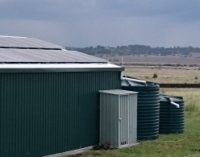
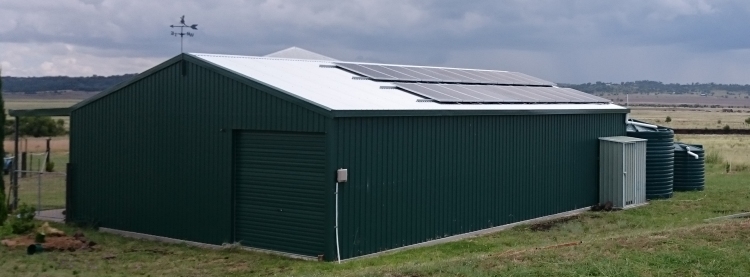
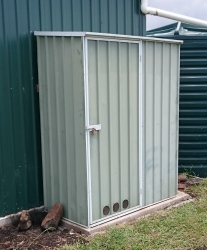
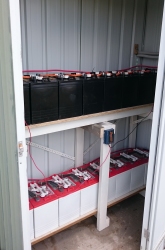
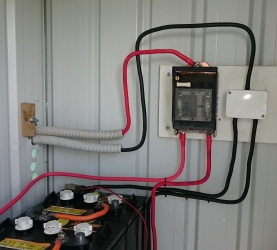
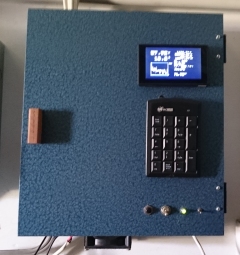 Charge Regulator to correctly charge the battery bank.
Charge Regulator to correctly charge the battery bank. 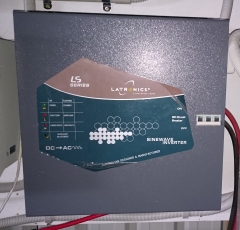 Inverter to supply the 240vac from the battery bank.
Inverter to supply the 240vac from the battery bank. 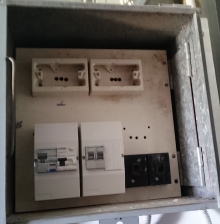
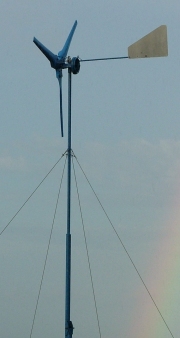 The windmill.
The windmill.